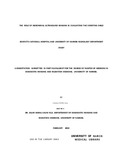The role of abdominal ultrasound imaging in evaluating the vomiting child
Abstract
Introduction: Children are generally very suitable subjects for ultrasound (US)
examinations. US is often the first investigation performed for suspected abdominal or
pelvic pathology. It may precede radiographic examination and has many advantages. It
is non-invasive, does not use ionizing radiation and can be performed quickly and
portably, if necessary. It is generally well tolerated by babies and children. Increasingly
in pediatric practice, ultrasound is used for investigating suspected disease of the hollow
gastrointestinal (GI) tract.
Aim: The aims of this study was to evaluate the sonographic abdominal findings in a
vomiting child, to establish indications for sonography and to show the disease patterns
that cause vomiting in children, that can be evaluated by ultrasound.
Method: A descriptive prospective study was carried out at the Radiology Department
of Kenyatta National Hospital and University Of Nairobi for duration of six months.
During this study period, all children referred to Kenyatta National Hospital and
University Of Nairobi Radiology Department for upper gastrointestinal tract contrast
study and/or ultrasound with history of vomiting was recruited in the study. Informed
consent was obtained from parents for each child participating in the study and the
study scanning protocol was followed. All ultrasound examinations was done by the
researcher under supervision of consultant radiologist. Data collection sheets were
used to record the personal, clinical data, sonographic findings and diagnosis. The data
was eventually analyzed using computer software and the results presented in form of
tables, charts and graphs.
Results: A total of 56 children under 12 years of age were investigated. 64.3% of the
children were male. The most common sonographic finding was intussusception which
was found in 32.1% and gastro-esophageal reflux (GER) in 28.6% of the patients. The
male to female ratio in intussusception was 1.5:1 while gastro-esophageal reflux male
to female ratio was 1.6:1.
1
The most common clinical presentation in children found to have intussusception was
palpable abdominal mass, and few of them presented with blood stained stool. More
than 2/3 of these children with gastro-esophageal reflux presented with complications
of recurrent pneumonia and failure to thrive. Gastro-esophageal reflux was more severe
in patients with recurrent pneumonia compare to those that presented without
complications.
Discussion: The result of this study indicates that transabdominal ultrasonography was
useful and highly specific in evaluating the vomiting child and can be considered a
valuable first choice examination. In some diseases of the gastrointestinal system, such
as hypertrophic pyloric stenosis, intussusception sonography has almost entirely
substituted contrast studies. Further more ultrasound is the only diagnostic examination
which can be repeated several times with high diagnostic accuracy. The technique offers
several advantages in that it has low costs, it is simple and non-invasive.
Conclusion: Findings in this study confirm that ultrasound is an accurate, reliable, and
rapid screening method to evaluate the causes of vomiting in children.
Recommendation: It is recommended that such children referred to the x-ray department
should have an initial sonographic examination and thereby avoid or limit the use of
ionizing radiation.
Citation
Master of medicine in Diagnostic imaging and radiation medicinePublisher
University Of Nairobi College of Health Sciences

